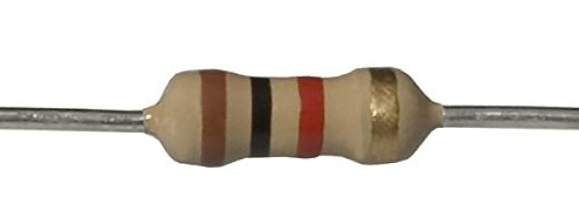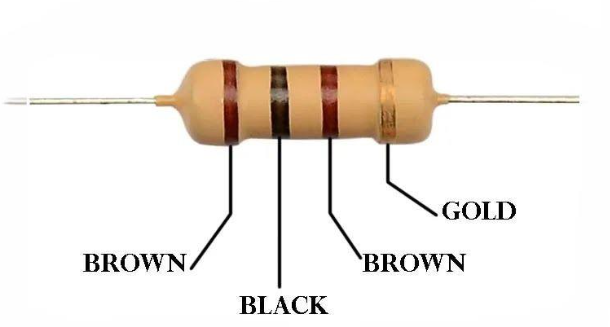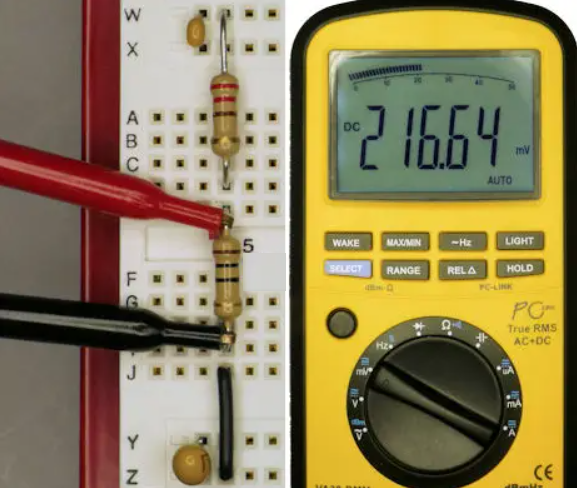What is a 10k Resistor? How to Read 10k Ohm Resistor Color Code?

What is a 10K Resistor?
A 10K resistor is a passive electronic component with a resistance value of 10,000 ohms. It is widely used in electronic circuits to control current flow, divide voltage, or pull-up/pull-down signals.
Resistors are essential in almost every electronic device, and the 10K resistor is one of the most common values. Whether you're building circuits or troubleshooting, understanding the 10K resistor is crucial.

What Does K Stand for on a Resistor?
The "K" in resistor values is a shorthand for 1,000 ohms. It makes it easier to read and write resistor values, especially when dealing with large numbers. So, instead of writing 10,000 ohms, we simply write 10K. This notation is standard in electronics and helps to simplify the identification and use of resistors in circuits. So 10K means 10,000 ohms.
How To Read the 10K Resistor Color Code?
Reading the 10K resistor color code is simple once you know the basics. Resistors are marked with colored bands, each representing a number. For a 10K resistor, the color code is typically brown, black, orange, and gold for a 4-band resistor. Here's how to read it:

l Brown represents 1
l Black represents 0
l Orange represents the multiplier 1,000
l Gold represents a tolerance of ±5%
When combined, brown (1) and black (0) give you 10. The orange band then multiplies this by 1,000, resulting in 10,000 ohms, or 10K. The gold band indicates the resistor's tolerance, meaning its actual value could vary by ±5%.
5-Band 10K Resistor Color Code
The 5-band color code adds an extra digit for greater precision, making it more suitable for applications where exact resistance values are critical. The 5-band code is particularly useful in professional and high-precision electronics. The bands are as follows:
|
Band Number |
Digit |
Color |
Value |
|
1 |
1st digit |
Brown |
1 |
|
2 |
2nd digit |
Black |
0 |
|
3 |
3rd digit |
Black |
0 |
|
4 |
Multiplier |
Red |
x 100 |
|
5 |
Tolerance |
Gold (or silver) |
+/-5% |
First Band (Brown): Represents the first digit, which is 1.
Second Band (Black): Represents the second digit, which is 0.
Third Band (Black): Represents the third digit, which is 0.
Fourth Band (Red): This is the multiplier, indicating that the first three digits should be multiplied by 100.
Fifth Band (Gold): Indicates the tolerance, which is typically ±5% or can be as low as ±1% for higher precision resistors.
For a 10K resistor, the 5-band color code is typically brown, black, black, red, and gold. This configuration provides a more exact resistance value, which is beneficial in circuits where even slight deviations can affect performance.
6-Band 10K Resistor Color Code
The 6-band color code is the most detailed, adding a sixth band that represents the temperature coefficient, which indicates how much the resistor’s value will change with temperature. This information is crucial in applications where the circuit operates across a wide range of temperatures, ensuring the resistor maintains its accuracy.
First Band (Brown): Represents the first digit, which is 1.
Second Band (Black): Represents the second digit, which is 0.
Third Band (Black): Represents the third digit, which is 0.
Fourth Band (Orange): This is the multiplier, indicating the first three digits should be multiplied by 1,000.
Fifth Band (Gold): Indicates the tolerance, usually ±5%.
Sixth Band (Brown/Red/Other): Indicates the temperature coefficient, typically measured in ppm/°C (parts per million per degree Celsius).
Please be noted that last two bands, the fifth and sixth, which should be closely spaced, with a gap between the fourth and fifth bands.
For a 10K resistor, a possible 6-band color code might be brown, black, black, orange, gold, and brown. The final band (brown in this case) indicates a temperature coefficient of 100 ppm/°C, meaning the resistance value could change by 100 parts per million for every degree Celsius change in temperature.
Why Use a 10K Resistor?
The 10K resistor is a versatile component, used in a wide range of applications. Its value is suitable for many standard circuit designs, providing enough resistance to limit current without overly complicating the circuit. It is often used in voltage dividers, pull-up and pull-down resistors, and other basic circuits.
How Much Voltage Does a 10K Resistor Drop?
The voltage drop across a 10K resistor depends on the current flowing through it, according to Ohm's Law, which states:
V=I×R
In this format,
l V is the voltage drop
l I is the current in amperes
l R is the resistance in ohms
For instance, if 1mA (0.001A) of current flows through a 10K resistor, the voltage drop would be:
V=0.001×10,000=10V
So, the resistor drops 10 volts in this scenario. The actual voltage drop will vary depending on the current, so it's essential to calculate it based on your specific circuit.
Can I Use a 10K Resistor for LED?
Yes, you can use a 10K resistor with an LED, but it may not be the most suitable choice. LEDs typically require a specific current to operate correctly, usually between 10mA and 20mA. A 10K resistor may limit the current too much, resulting in a dim LED.
For most LEDs, a resistor between 220 ohms and 1K ohms is more appropriate. However, if you need a very dim LED or are working with a sensitive circuit, a 10K resistor might be used to ensure low current.
Can I Use 10K Resistor Instead of 4.7K?
Using a 10K resistor instead of a 4.7K resistor is possible, but it will change the circuit's behavior. The higher resistance will reduce the current or change the voltage drop in the circuit, which could affect the performance.
In some cases, this substitution might be acceptable if the circuit can tolerate the difference. However, in precision circuits or those designed with specific resistor values in mind, it’s better to use the correct value to avoid any unintended effects.
How Do You Test a 10K Resistor with a
Multimeter?
Testing a 10K resistor with a multimeter is a straightforward process that helps you verify its resistance value and ensure it is functioning correctly. Here’s a step-by-step guide to accurately measure a 10K resistor using a multimeter:

1. Set Up the Multimeter
Start by powering up your multimeter. And then set the multimeter to measure resistance. This is often indicated by the symbol Ω (ohms) on the dial or screen.
2. Prepare the Resistor
Ensure the resistor is removed from any circuit before measuring. Measuring a resistor in-circuit can give inaccurate results due to the influence of other components. Locate the two leads or terminals of the resistor.
3. Measure the Resistance
Place the multimeter probes on either end of the resistor. It does not matter which probe goes on which lead because resistance measurement is non-polarized. Read the multimeter’s display. The reading should be close to the resistor’s nominal value of 10,000 ohms (10K ohms).
4. Interpret the Results
If the display shows a value near 10K ohms, the resistor is functioning correctly. For instance, a reading between 9.5K and 10.5K ohms would be within the typical tolerance range of ±5%.
However, if the multimeter shows a value significantly different from 10K ohms, the resistor might be damaged or out of specification. Values far outside the expected range could indicate a broken or degraded resistor.
5. Additional Tips
If the resistor is marked with a tolerance band (e.g., gold or silver), remember that the actual resistance value might vary within the tolerance range. A 10K resistor with a ±5% tolerance can have an actual resistance between 9.5K and 10.5K ohms.
Common Issues
1. Zero or Infinite Reading: If the multimeter shows zero resistance or an infinite reading, this could indicate a short circuit or an open circuit, respectively. Verify that the resistor is properly isolated and that the multimeter is functioning correctly.
2. Inconsistent Results: If the resistor value fluctuates or shows inconsistent readings, it could be due to poor contact between the probes and the resistor leads, or the resistor may be damaged.
Pull-Up Resistors
Pull-up resistors are used in digital circuits to ensure that a pin is at a defined logic high level when not actively driven by another component. A 10K resistor is a popular choice for pull-up applications due to its ability to pull the pin to a high state without drawing too much current.
In a typical pull-up configuration, the resistor is connected between the pin and the positive supply voltage. When no other component drives the pin, the resistor "pulls" it up to the supply voltage level, ensuring a high logic state. This is especially important in microcontroller circuits where a floating input could lead to unpredictable behavior.
For example, in an open-drain or open-collector configuration, the 10K pull-up resistor ensures that the output remains high when the transistor is off, providing a clear and stable logic level.
Pull-Down Resistors
Pull-down resistors serve a similar purpose but are used to pull a pin to a logic low level when it is not actively driven. A 10K resistor is also commonly used in this role due to its ability to maintain a low state without significant power consumption.
In a pull-down configuration, the resistor is connected between the pin and ground. When no other component drives the pin, the resistor "pulls" it down to ground, ensuring a low logic state. This is vital in circuits where an unconnected or floating pin could lead to erratic behavior.
Pull-down resistors are often used in push-button circuits to ensure that the input reads as low when the button is not pressed. When the button is pressed, the pin is connected to the supply voltage, overriding the pull-down resistor and changing the input state to high.
Applications of 10K Resistor
The 10K resistor is a highly versatile component used in a wide range of electronic applications. Its resistance value makes it suitable for tasks that require moderate current limiting or voltage division. Some common applications include:
Voltage Dividers
A 10K resistor is often used in voltage divider circuits to create a specific voltage output from a higher voltage input. This is crucial in applications where precise voltage levels are needed.
Signal Conditioning
In analog and digital circuits, 10K resistors can be used to shape or condition signals, ensuring they meet the necessary specifications for further processing.
Current Limiting
The 10K resistor can limit the current in a circuit, protecting sensitive components from damage due to excessive current flow.
Timing Circuits
Combined with capacitors, 10K resistors can create RC timing circuits, which are used in oscillators, timers, and filters.
Sensor Interfaces
Many sensors require pull-up or pull-down resistors to function correctly, and the 10K value is commonly used in these interfaces.
FAQs
1. What is the tolerance of a 10K resistor?
The tolerance of a 10K resistor is often ±5% (gold band) for standard resistors, but it can vary depending on the specific resistor type.
2. How do I know if a 10K resistor is
working correctly?
Measure the resistor with a multimeter; if the value is close to 10K (within tolerance), it's working correctly.
3. Can I use a 10K resistor in a voltage divider?
Yes, a 10K resistor is commonly used in voltage dividers, often paired with other resistors to achieve the desired voltage output.
4. What happens if I replace a 10K resistor with a 1K resistor?
Replacing a 10K resistor with a 1K resistor will decrease the resistance, increasing the current or changing the voltage drop, which could alter circuit behavior.
5. Why does my 10K resistor get hot?
If a 10K resistor gets hot, it might be dissipating more power than it’s rated for. Ensure it’s used within its power rating to avoid damage.
Related Content
1. What is Resistor – Definition, Types & Resistor Symbol
2. What is Transistor - Definition, Types, Transistor Symbol
3. 220 Ohm Resistor Color Code, Symbol and Applications
4. LR41 Battery Equivalent & Replacements Introduction
5. IC 741 Op Amp: Pin Diagram, Working & Equivalents
Statement
All articles (images, texts, audio) on this site are uploaded and shared by users, or integrated from relevant internet sources, only for user's learning. If your rights are violated, please contact the administrator to delete! Link to this article: https://www.jinftry.com







